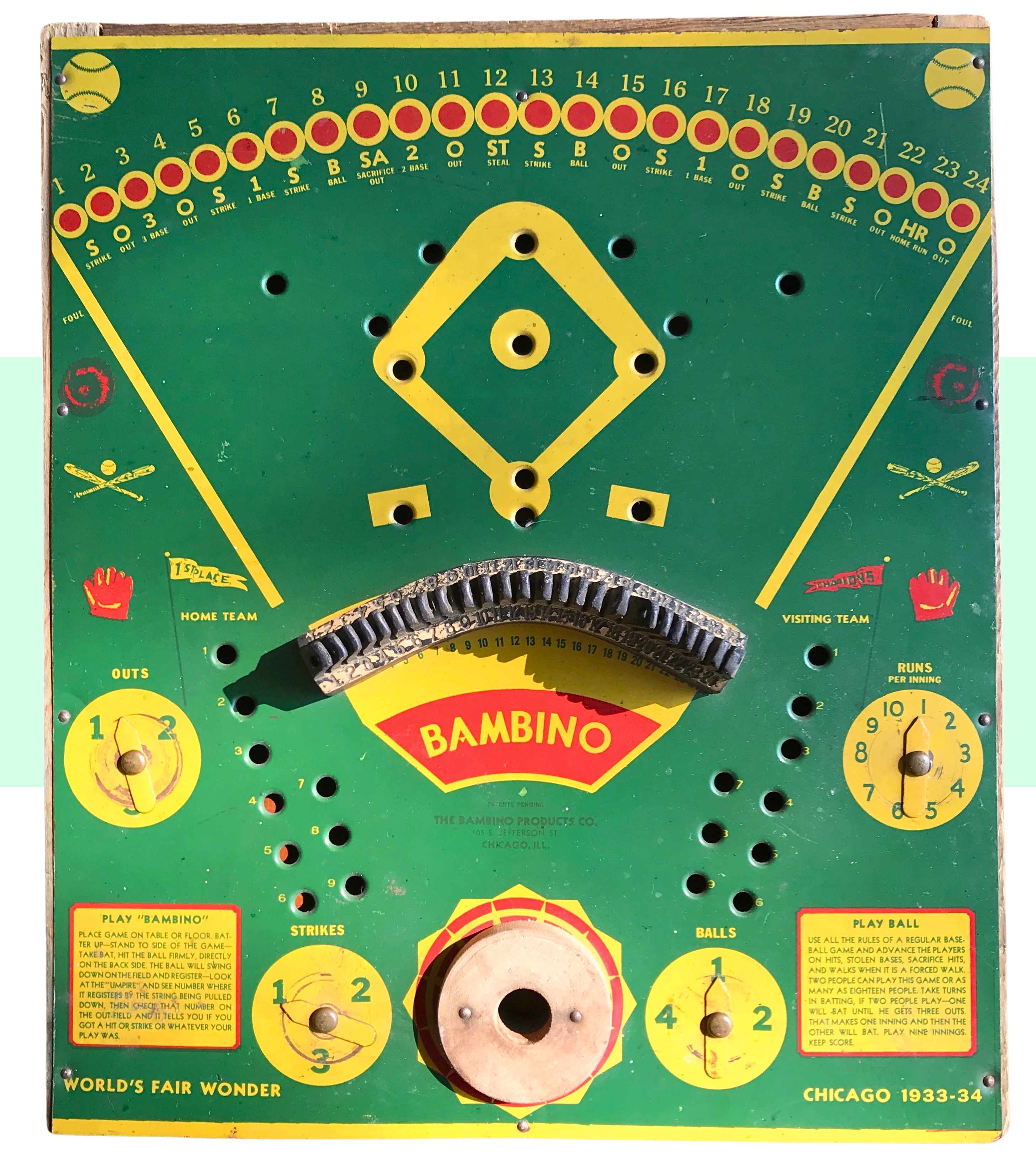
Museum Artifact: Bambino World’s Fair Baseball Board Game, 1933
Made By: The Bambino Products Co., 103-105 S. Jefferson St., Chicago, IL [West Loop]
George Herman “Babe” Ruth—the Great Bambino—was arguably the most famous person in the United States in 1933. Even in the twilight of his baseball career, at age 38, he was literally and figuratively a larger-than-life character; a celebrity as much as a sportsman. So it’s not surprising that an endless line of commercial enterprises were eager to piggyback off his popularity—even more so during the Great Depression, perhaps, when Ruth still represented the comparative fun and excess of the decade past.
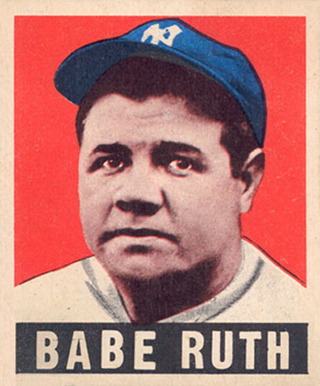 In some cases, the Babe was directly approached for product endorsements and gladly took a paycheck to do so. In others, like the “Baby Ruth” candy bar or our “Bambino” table-top game here, the manufacturer took a sneakier, more affordable approach, using unlicensed Ruth-ian code words or nicknames to achieve the same marketing goal.
In some cases, the Babe was directly approached for product endorsements and gladly took a paycheck to do so. In others, like the “Baby Ruth” candy bar or our “Bambino” table-top game here, the manufacturer took a sneakier, more affordable approach, using unlicensed Ruth-ian code words or nicknames to achieve the same marketing goal.
Chicago’s Curtiss Candy Company, which launched the Baby Ruth bar in 1921 (the year after Ruth smashed a Major League record 54 home runs and became a superstar), shamelessly claimed for years that the snack was actually named after the daughter of ex-president Grover Cleveland (it wasn’t). As for the so-called Bambino Products Company—maker of the 1933 “World’s Fair Wonder” in our museum collection—it’s not clear if a public defense of its trademark was ever necessary. The product’s brief lifespan and limited distribution appear to have helped it come-and-go without facing legal action from the Sultan of Swat himself.
For the same reasons, we don’t know an awful lot about the Bambino baseball game itself or those who produced it. The bread crumbs of its origin story, however, all point to a man named George Henry Mansfield.
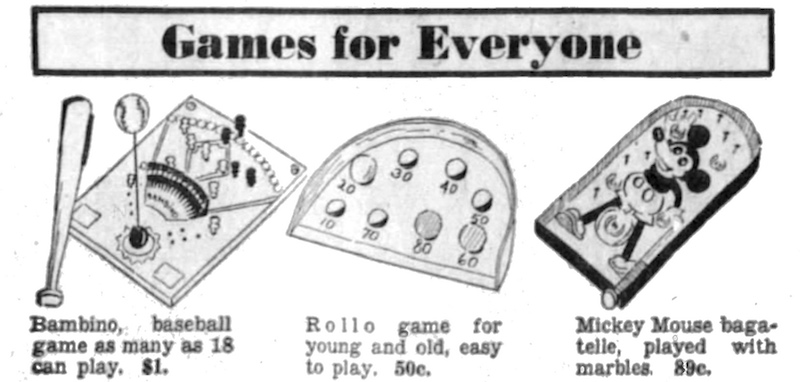 [The Bambino baseball game, challenging a Mickey Mouse marble game for toy supremacy in 1933, from an ad for the Younkers department store in Des Moines, Iowa]
[The Bambino baseball game, challenging a Mickey Mouse marble game for toy supremacy in 1933, from an ad for the Younkers department store in Des Moines, Iowa]
Creating the Game
Born in Canton, Ohio, in 1889, George H. Mansfield eventually made his home in nearby Cuyahoga Falls, where he worked as a bookkeeper by day, frustrated intellectual by night. A proto social-media nerd of sorts, he seemed to have two favorite pastimes (besides baseball): sending long-form political editorials to the Akron Beacon Journal (“A vote for Hoover is in my opinion a vote for a jellyfish”) and tinkering with tabletop game designs of his own creation. In 1932, perhaps as a consequence of losing his day job during the Depression, a 43 year-old Mansfield turned the latter hobby into a new legitimate business pursuit.
His central focus, from the beginning, was mass producing a novelty baseball game he’d devised, featuring an actual 12″ miniature bat and a 2″ diameter ball attached to a swaying metal tee. Renting some manufacturing space in an old flour and grist mill in Cuyahoga Falls, Mansfield started looking for investors and distributors; no easy task in the early 1930s. From the looks of it, though, he eventually found his partners in the form of representatives from the Johnson Store Equipment Company in Elgin, IL, who were gearing up their catalog for Chicago’s upcoming “Century of Progress” World’s Fair in 1933.
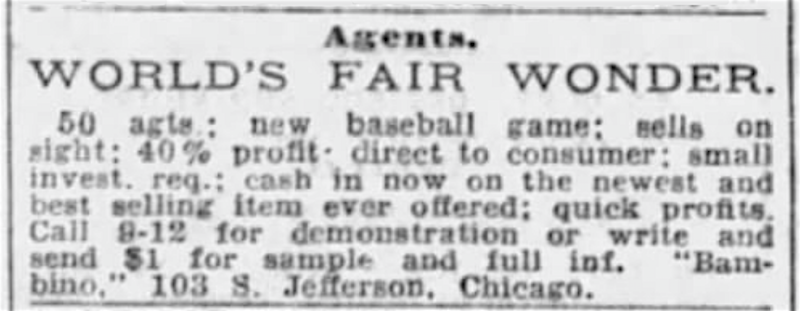 [1933 want ad from the Chicago Tribune, seeking 50 sales agents to peddle the new Bambino game during the World’s Fair]
[1933 want ad from the Chicago Tribune, seeking 50 sales agents to peddle the new Bambino game during the World’s Fair]
As for how the name “Bambino” came into the picture, it’s a bit of a chicken and the egg situation. In 1933, the Bambino Products Company was organized in Chicago, with a sales office at 103-105 S. Jefferson Street. The business, which was likely just a small branch of the already small Johnson Store Equipment Co., appears to have had a grand total of two products in its arsenal: the Bambino game and a Bambino short-wave radio receiver (which quite possibly never left the prototype stages). As for which one came first and who hatched the idea of cashing in on the all-star’s nickname, we will likely never know.
It’s worth noting that while Babe Ruth played most of his career in New York Yankee pinstripes, he was certainly no stranger to Chicago. His mythical “called shot” home-run in the 1932 World Series had come at Wrigley Field just a year prior to the Bambino game’s release, and he made far more regular visits to the South Side to face the Yanks’ American League rivals, the White Sox. It was at the Sox stadium, Comiskey Park, in fact, that the first Major League All-Star Game was held in 1933—a tie-in event with the aforementioned World’s Fair. Odds are good that some of the kids who attended that game also came home with a “Bambino” board, whether Mr. Ruth knew about it or not.
Playing The Game
Various evolving versions of George Mansfield’s Bambino game were available, sporadically, throughout the 1930s into the mid 1940s [a wholly unrelated “Bambino” pinball game was also produced in 1938 by the Bally MFG Co.]. The original “World’s Fair Wonder” model from our museum collection, however, was only sold during a very specific time period and in a fairly condensed region of the country, i.e., the Midwest, in 1933 and ’34. It’s pretty rare to find any of these boards for resale these days, and much rarer still to see one still equipped with the original box and all the extraneous components required to play (our museum piece is sadly lacking most of those things).
For those collectors lucky enough to have the whole glorious set, then, the next question becomes, how exactly do you play the game? Well, back in the ’30s, these types of penny arcade games were pretty familiar to the average kid, and at least a few comparable at-home baseball games had appeared on the market before. Still, was Bambino really as simple, enjoyable, and “realistic” as the newspaper ads of the day suggested?
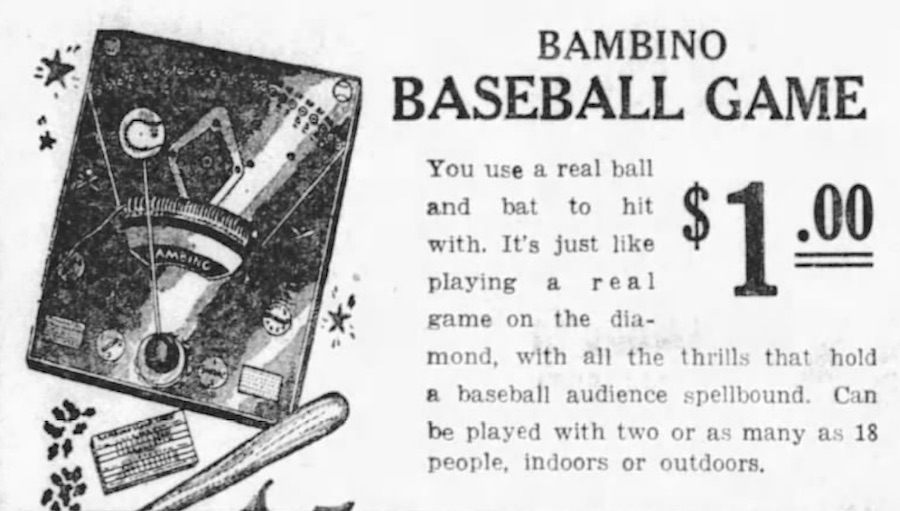
“Play like the Bambino himself!” claimed one toy shop ad, listing the game at 98 cents. “You actually hit the ball with your bat and play according to your hit.”
“It’s just like playing a real game on the diamond,” said another, “with all the thrills that hold a baseball audience spellbound. Can be played with two or as many as 18 people, indoors or outdoors.”
The original Bambino board features a tin front panel with a wood backing, and measures 12” x 14” (a larger, harder-to-find version also exists). On first sight, it might look like one of those mid-century baseball dice games or something like Strat-O-Matic or Cadaco’s All-Star Baseball—utilizing probabilities and stats to create imaginary baseball scenarios. But it was a lot less cerebral than all that.
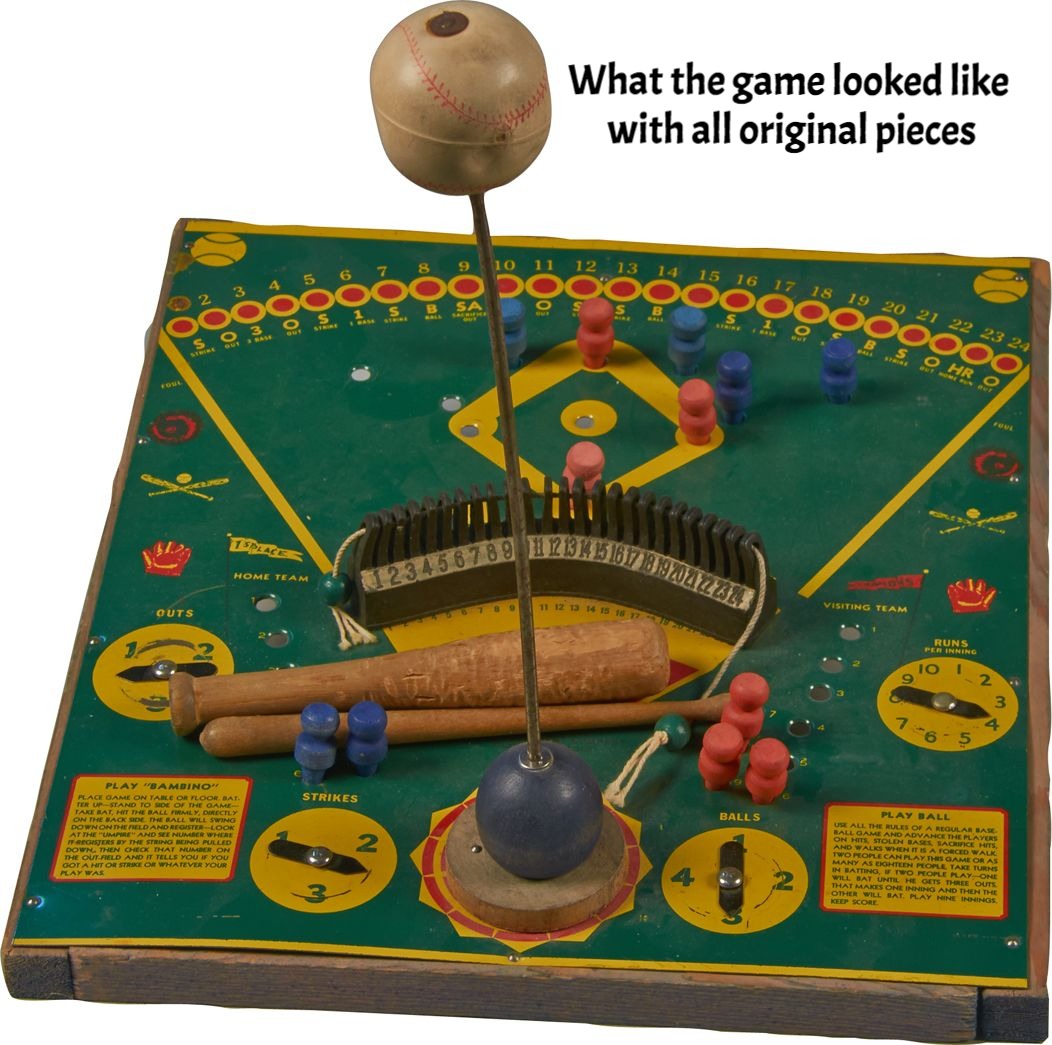 As mentioned, the game was quite literally played by physically taking the bat and hitting the ball—which was attached to a sort of protruding metal tee at the bottom of the board, with a spring running underneath it. Once hit, the ball would push the metal tee forward, smushing it between two of the 25 rubber teeth laid out in an arch shape under home plate. These teeth were collectively known as “the umpire.” (Confused yet?) As such, when the ball sprang back, a string running through those teeth would be snared, revealing the “result” of your at-bat, which could be identified by referencing the matching numbers on the “outfield wall.” A set of wooden peg baserunners, along with ball/strike dials and official scorecards, allowed kids to track the action inning by inning.
As mentioned, the game was quite literally played by physically taking the bat and hitting the ball—which was attached to a sort of protruding metal tee at the bottom of the board, with a spring running underneath it. Once hit, the ball would push the metal tee forward, smushing it between two of the 25 rubber teeth laid out in an arch shape under home plate. These teeth were collectively known as “the umpire.” (Confused yet?) As such, when the ball sprang back, a string running through those teeth would be snared, revealing the “result” of your at-bat, which could be identified by referencing the matching numbers on the “outfield wall.” A set of wooden peg baserunners, along with ball/strike dials and official scorecards, allowed kids to track the action inning by inning.
Were you able to visualize anything described above? No? Good, because I’m right there with you.
I’ll be honest. I love baseball. I played baseball. I have written about baseball for years. I know the complexities of the game. . . . And I am still struggling mightily to figure out how this Bambino game works. Let’s try sorting through the directions again, this time straight from the board itself.
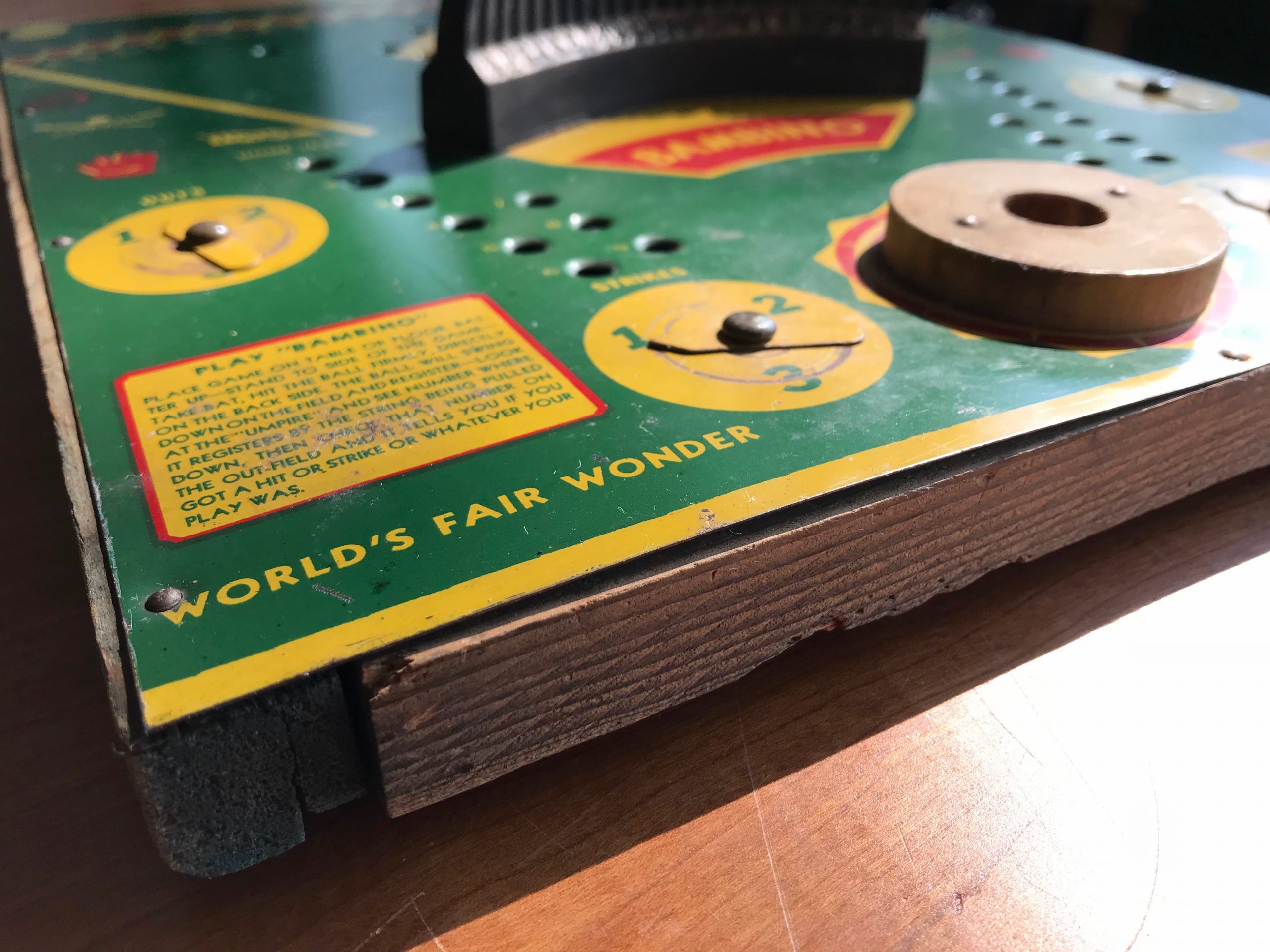
“Place game on table or floor. Batter Up. Stand to side of the game. Take bat, hit the ball firmly, directly on the back side. The ball will swing down on the field and register. Look at the “umpire” and see number where it registers by the string being pulled down. Then check that number on the outfield and it tells you if you got a hit or strike or whatever your play was.”
Good lord, man. Didn’t the children of the Great Depression have enough things to worry about? These instructions read more like the kind you’d get with a bootlegged Korean DVD player.
Anyway, I’m sure it was a blast once you got the hang of it. And if the internet ever provides a useful video of the gameplay, in live action for our education, I’ll be happy to share it.
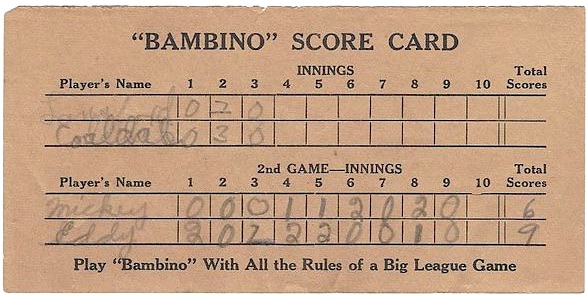
Bambino’s Second Life
So, yes, Bambino might have been a bit complicated (and potentially dangerous) for your average 5 year-old, but there is no denying that the game’s unusual, mildly violent format and number-crunching geektitude appealed to a certain demographic quite effectively. As such, even after it had moved on from its “World’s Fair Wonder” status, the game remained in demand and available in various toy departments, with G. H. Mansfield still leading its production out of Ohio.
For a short time, a slightly updated version of Bambino was distributed under the Johnson Store Equipment Co. banner, suggesting that the Bambino Products Co. was probably put to bed after the World’s Fair. By 1935, however, George Mansfield appears to have been looking for a fresh start, as laid out in a highly informative advertisement he posted in a February edition of the Evening Independent newspaper in Massillon, Ohio.
“A Real Business Opportunity As a Massillon Industry”
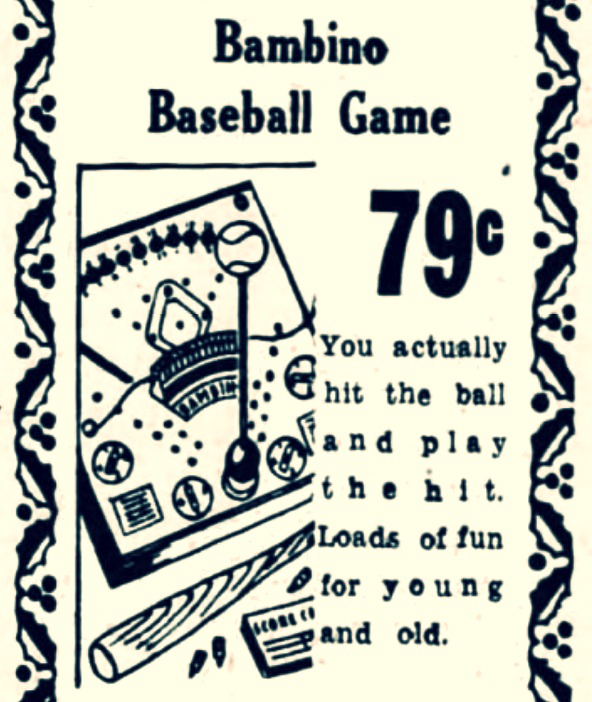 “I am the inventor and patentee of this proposition, and offer a real going business to an honest, earnest party with some finances. It is well known that good manufacturing businesses offer the greatest profits. Also, most businesses fail because they cannot make the initial hurdle. Herein lies the attraction of my business. It started in 1932, went strong in 1933 and 1934, and now as a going business it is back on my hands because my partner lacked capital and his $30,000.00 missionary work offers a harvest you can now step in and reap.
“I am the inventor and patentee of this proposition, and offer a real going business to an honest, earnest party with some finances. It is well known that good manufacturing businesses offer the greatest profits. Also, most businesses fail because they cannot make the initial hurdle. Herein lies the attraction of my business. It started in 1932, went strong in 1933 and 1934, and now as a going business it is back on my hands because my partner lacked capital and his $30,000.00 missionary work offers a harvest you can now step in and reap.
“This is the famous ‘Bambino’ baseball game, so realistic and ‘physical’ that it will last forever. Sales in the season just closed were practically confined to Chicago and St. Louis, where the business amounted to $25,000. Marshall Field alone sold $3200 worth. Styx in St. Louis $3800. Sears Roebuck’s 64th St. store $2400. It now goes in a mail-order catalog. 99% of the business has not yet been tapped. In our season we employed 35 people in the shop. All dies, molds and plates are made. I have other items to round out the seasons.
“If you have cash or credit, and really want a buzzing manufacturing business, I will split the profits and you can have control. Two other factories are after me, but this will be better. Write: G.H. Mansfield, 2057 Fifth St., Cuyahoga Falls, O.”
Did Mansfield find his new partner and cash in on the remaining “99 percent” of Bambino’s supposed market value? Well, not exactly. While the enterprise might have trickled along for a while, the lingering Depression took its toll during the late ’30s, to the point where George Mansfield lists his occupation in the 1940 census as “stenographer.”
When the U.S. entered World War II, any hope of re-igniting his old manufacturing business probably seemed all the more far fetched, but to Mansfield’s credit, he stuck with the dream. After the war, he joined forces with his son-in-law Denton Zesiger, re-organizing the old toymaking factory as the Mansfield & Zesiger MFG Co. (alternately known as the Mansfield Products Co.). George’s own son John soon joined the effort, as well, as a new, fully updated version of Bambino led the company’s product line in 1946.
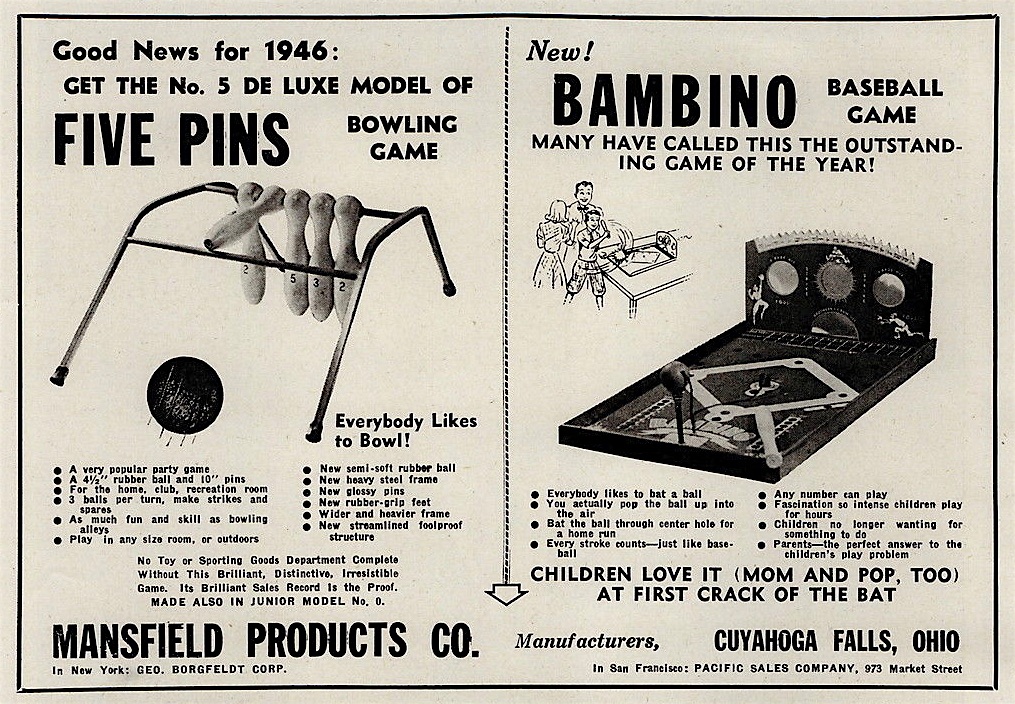 [The new Bambino game in 1946 featured a different design with 3 hole targets in the now elevated outfield wall. The game was joined by other Mansfield offerings like the mini Five Pins bowling game]
[The new Bambino game in 1946 featured a different design with 3 hole targets in the now elevated outfield wall. The game was joined by other Mansfield offerings like the mini Five Pins bowling game]
George Mansfield was still just 57 when Bambino re-entered the market. This time, it seemed, the game might gain the traction and economic stability to become a classic. Unfortunately, the ball didn’t bounce in that direction.
In 1949, Mansfield died of a heart attack, just a year after the mighty Babe Ruth himself had breathed his last. It was only after his death that George’s revised Bambino game earned an official U.S. patent, assigned to his widow Emma Mansfield.
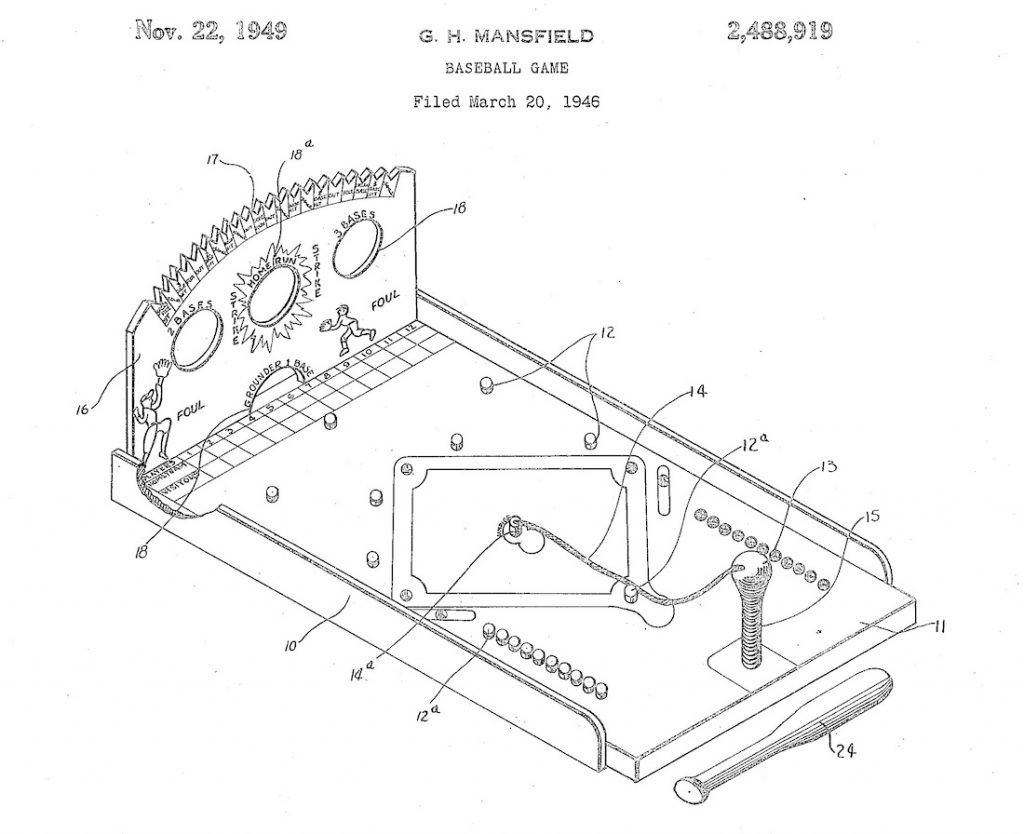 [The patent for George Mansfield’s last “Bambino” game design was approved in November of 1949, several months after his death]
[The patent for George Mansfield’s last “Bambino” game design was approved in November of 1949, several months after his death]
John Mansfield, meanwhile, couldn’t bring himself to shut down the family business after his father’s death. He kept the Mansfield-Zesiger MFG Co. going, essentially by himself, for another decade, producing a small selection of specialty toys and athletic supplies. Sadly, a major fire in 1959 torched the company’s Cuyahoga Falls offices at 2060 Water Street, dashing any hopes of a third era for the Bambino game.
The old offices of the Bambino Products Company in Chicago have long since been demolished, as well, leaving only the faintest of echoes of this sprightly little enterprise. “Bambino” was an innovative concept that never quite tapped its full potential, as George Mansfield once saw it, but at the very least, the game board would still make a lovely addition to someone’s man cave—a relic not only of baseball’s past, but of new ideas still taking flight in one of America’s darkest periods.
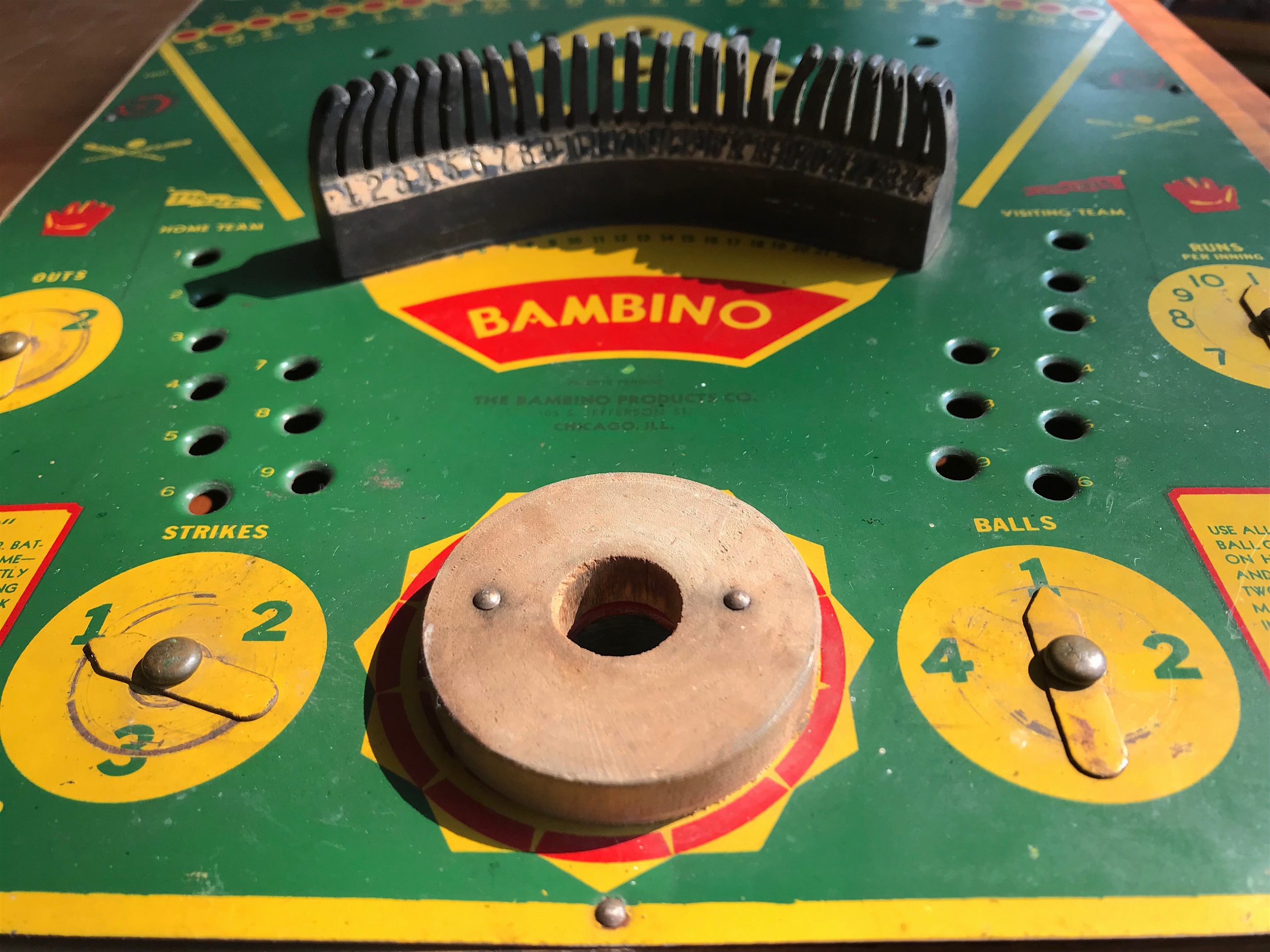
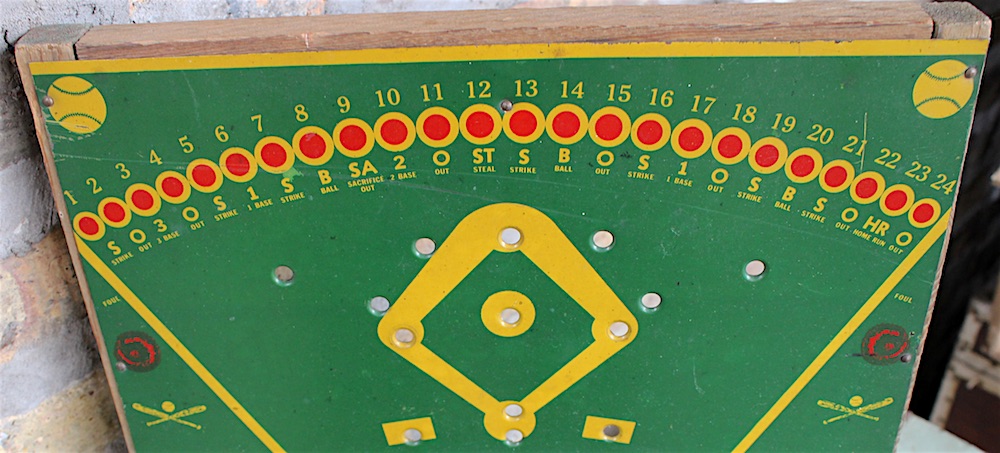
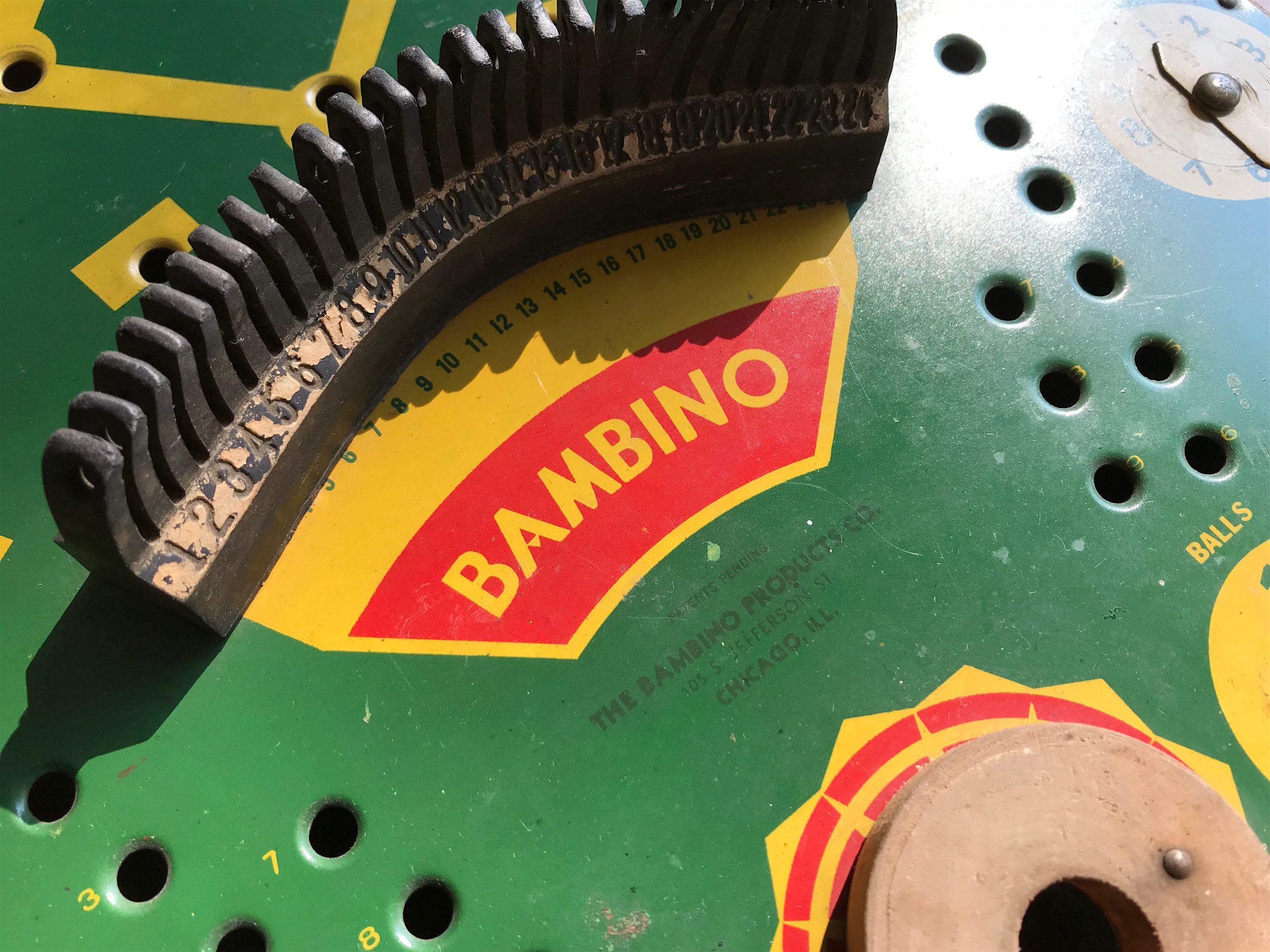
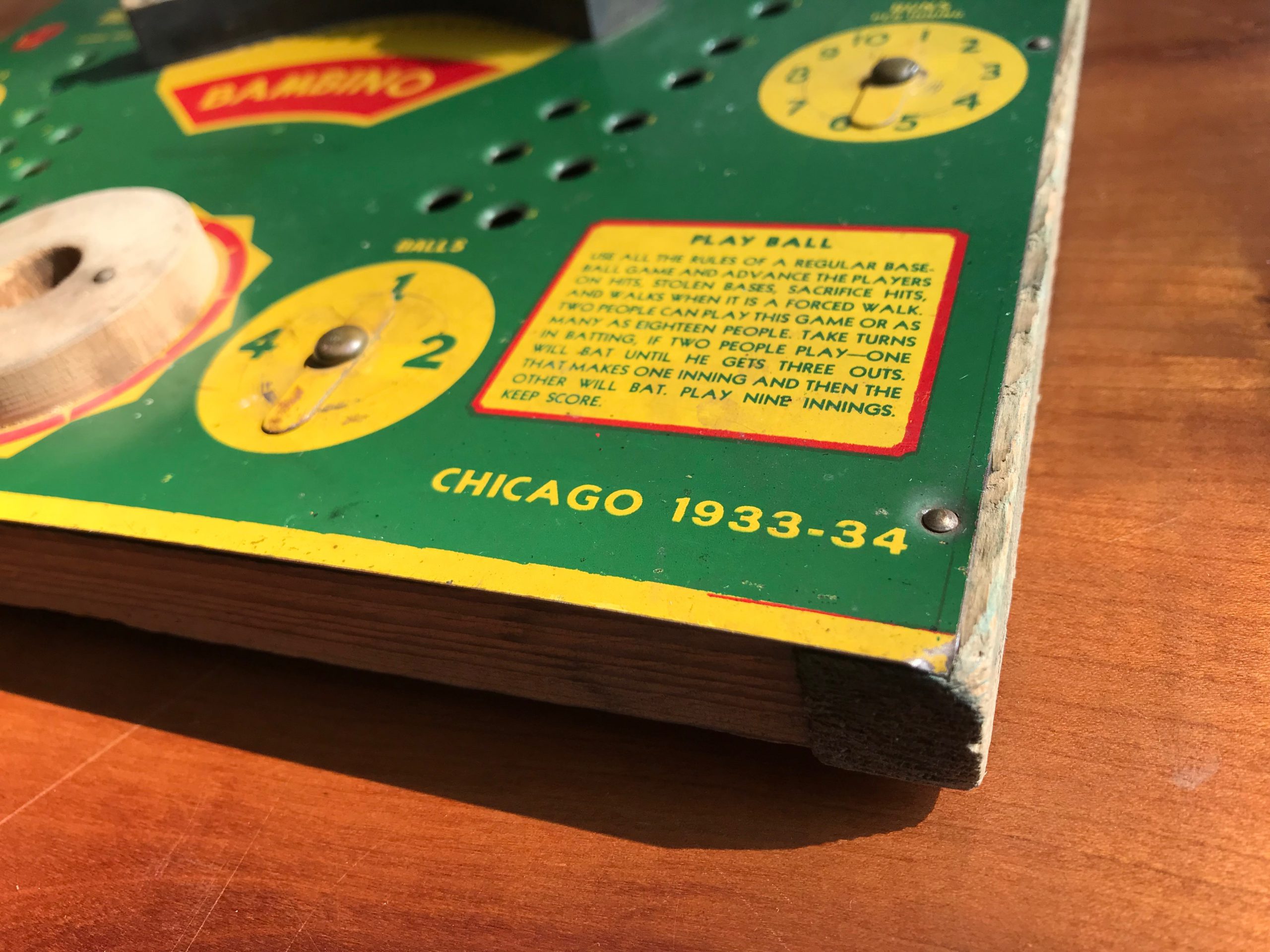
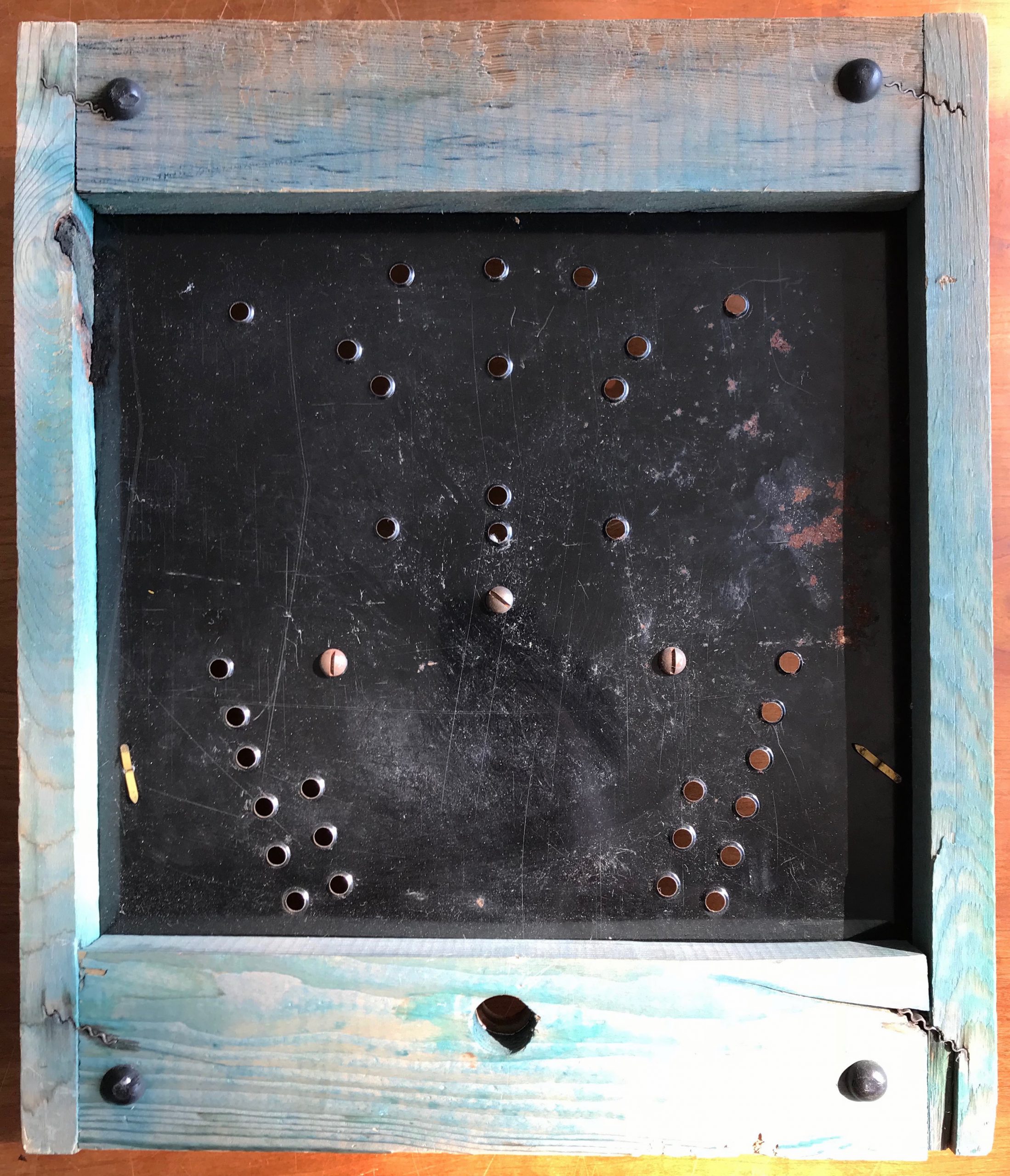

SOURCES:
“Baseball Game” – U.S. Patent 2,488,919, Nov. 22, 1949
“A Real Business Opportunity as a Massillon Industry” – The Evening Independent (Massillon, OH), Feb 18, 1935
“Bambino” – Board Game Geek
“Toy Creator, Mansfield, Dies at Falls” – Akron Beacon Journal, April 23, 1949
Commercial America, Vol. 30, p. 18, 1933
“Letters to the Editor” – Akron Beacon Journal, Aug 2, 1932
Mansfield Products Co. advertisement – Playthings, April 1946
“$50,000 Fire Eats Out Falls Building” – Akron Beacon Journal, June 21, 1959

Dear Sir,
I own a vintage Johnson Babino game w box bat ball etc.
Can you give me any information on current value of such a game?
Hi…any idea where I could get the 4.5 round rubber ball , used in the Mansfield Zesiger “5 pin”
Table top bowling game? I’d appreciate any ideas or clues as to find said rubber ball Thanks 😊